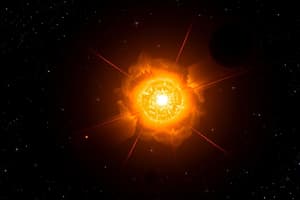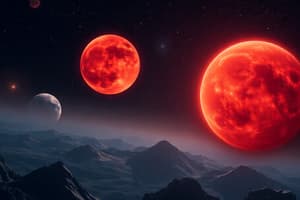Podcast
Questions and Answers
What is the source of energy for main sequence stars?
What is the source of energy for main sequence stars?
- The triple-α process
- Fusion between helium nuclei
- The degenerate core
- The proton-proton chain and the CNO cycle (correct)
What temperature is required for helium to be converted to carbon through the triple-α process?
What temperature is required for helium to be converted to carbon through the triple-α process?
- 10 million degrees
- 1 billion degrees
- 50 million degrees
- 100 million degrees (correct)
What happens to the core of a star when the electrons and helium nuclei become degenerate?
What happens to the core of a star when the electrons and helium nuclei become degenerate?
- It expands rapidly
- It becomes incompressible and further contraction stops (correct)
- It transforms into a gas
- It becomes less dense
Why does helium require higher temperatures to fuse compared to hydrogen?
Why does helium require higher temperatures to fuse compared to hydrogen?
What leads to the formation of carbon and oxygen nuclei in stars?
What leads to the formation of carbon and oxygen nuclei in stars?
What prevents expansion of the core despite increased temperature in stars?
What prevents expansion of the core despite increased temperature in stars?
What causes stars to become horizontal branch stars?
What causes stars to become horizontal branch stars?
What process leads to the formation of dust particles important for interstellar clouds and proto-solar systems?
What process leads to the formation of dust particles important for interstellar clouds and proto-solar systems?
What causes the RGB bump in the evolution of red giant stars?
What causes the RGB bump in the evolution of red giant stars?
At what temperatures do stars reach the tip of the red-giant branch at solar metallicity?
At what temperatures do stars reach the tip of the red-giant branch at solar metallicity?
What happens to stars initially more massive than 2 M☉ during their evolution?
What happens to stars initially more massive than 2 M☉ during their evolution?
What determines the mass and properties of the white dwarfs that form subsequently from red giants?
What determines the mass and properties of the white dwarfs that form subsequently from red giants?
What causes a spread of stars along the horizontal branch (HB) at constant luminosity?
What causes a spread of stars along the horizontal branch (HB) at constant luminosity?
What are the characteristics of extreme horizontal branch stars?
What are the characteristics of extreme horizontal branch stars?
What causes the RR Lyrae gap in globular cluster color-magnitude diagrams (CMDs)?
What causes the RR Lyrae gap in globular cluster color-magnitude diagrams (CMDs)?
What determines the differences in radii, effective temperatures, and color of the red clump, a population I counterpart to HB stars?
What determines the differences in radii, effective temperatures, and color of the red clump, a population I counterpart to HB stars?
What type of stars are powered by helium fusion in the core and by hydrogen fusion in a shell surrounding the core?
What type of stars are powered by helium fusion in the core and by hydrogen fusion in a shell surrounding the core?
What initiates fusion more smoothly without a flash in stars with larger helium cores?
What initiates fusion more smoothly without a flash in stars with larger helium cores?
What class of variable stars with amplitudes of a few thousandths of a magnitude and semi-regular periods of 10 – 100 days was discovered through microlensing surveys?
What class of variable stars with amplitudes of a few thousandths of a magnitude and semi-regular periods of 10 – 100 days was discovered through microlensing surveys?
What type of stars experience the initiation of helium fusion through the triple-alpha process, causing a temperature rise and rapid increase in fusion rate?
What type of stars experience the initiation of helium fusion through the triple-alpha process, causing a temperature rise and rapid increase in fusion rate?
Flashcards are hidden until you start studying
Study Notes
Stellar Evolution and Variability in Red Giants
- Mass lost by more-massive stars leaving the red-giant branch before the helium flash is challenging to measure directly.
- Current mass of Cepheid variables like δ Cephei can be accurately measured due to binaries or pulsating stars, with an apparent 20% mass loss, mostly during the blue loop and pulsations.
- Some red giants are large amplitude variables, including Mira variables, semiregular variables, and slow irregular variables, previously considered to be asymptotic giant branch (AGB) or supergiants.
- Studies in the late 20th century showed that all giants of class M were variable, with amplitudes of 10 milli-magnitudes or more, and late K class giants were also likely to be variable with smaller amplitudes.
- Microlensing surveys in the 21st century provided accurate photometry, leading to the discovery of a new class of variable stars called OGLE Small Amplitude Red Giants (OSARGs) with amplitudes of a few thousandths of a magnitude and semi-regular periods of 10 – 100 days.
- Thousands of OSARGs were detected in the Magellanic Clouds and a catalog of 192,643 OSARGs in the direction of the Milky Way central bulge was published.
- Horizontal-branch stars are powered by helium fusion in the core and by hydrogen fusion in a shell surrounding the core, immediately following the red giant branch in stars similar to the Sun's mass.
- After exhausting core hydrogen, stars leave the main sequence, begin fusion in a hydrogen shell around the helium core, and become giants on the red giant branch.
- Stars with masses up to 2.3 times the mass of the Sun experience the initiation of helium fusion through the triple-alpha process, causing a temperature rise and rapid increase in fusion rate.
- Stars initially between about 2.3 M☉ and 8 M☉ have larger helium cores that do not become degenerate, triggering helium fusion before the core becomes degenerate.
- Non-degenerate cores initiate fusion more smoothly without a flash, and the output of the helium flash event is absorbed by the layers of plasma above, not visible from the exterior of the star.
- The evolutionary track of a sun-like star shows the horizontal branch and red clump region after core hydrogen exhaustion, with substantial changes in stellar structure and a reduction in luminosity.
Studying That Suits You
Use AI to generate personalized quizzes and flashcards to suit your learning preferences.




